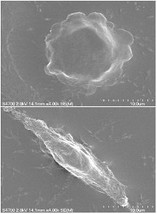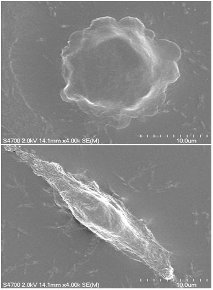/ News

On the Horizon: Implants with Built-in Sensors that Can Shake off Infection?
Keat Ghee Ong envisions a new generation of implantable biosensors. Not only could they signal if all is well (or not) after surgery, they would do it with no batteries and no computer chips. Plus, they could fight infection.
For his insights, the associate professor of biomedical engineering at Michigan Technological University was one of 24 Outstanding Young Investigators invited to present at the 2013 Frontiers in Bioengineering Workshop. The workshop, held at Georgia Tech Feb. 25-26, brought together leaders in bioengineering to discuss cutting-edge research in the field.
Here’s what makes Ong’s sensors radically different. Instead of being surgically inserted alongside a device such as an artificial knee, they would be part of the device itself. Ong is developing special coatings for surgical implants, like replacement hips and knees. Those coatings could tell doctors how well a patient is healing.
 The fibroblasts (cells involved in scar tissue formation) had adhered to a magnetoelastic coating. The top cell was subjected to vibration and became rounder and less sticky than the elongated cell, which was not vibrated.
The fibroblasts (cells involved in scar tissue formation) had adhered to a magnetoelastic coating. The top cell was subjected to vibration and became rounder and less sticky than the elongated cell, which was not vibrated.
Made of magnetoelastic materials, the coatings’ magnetic properties change under pressure. When scanned from outside the body, they could reveal if the patient’s bone is healing properly with an implant—or if it isn’t.
A magnetoelastic coating can even help battle infection. “It will vibrate in an AC magnetic field,” says Ong. That can knock bacteria loose from the surface, where antibiotics and the body’s own immune system can better launch an attack.
This property could also help solve another problem with implants. “If a cell attaches too much, a small vibration on the coating can loosen it and prevent cell growth,” Ong says. “The vibration tells the cell, ‘Don’t stand there, go away,’ in the gentlest way possible.”
The property could also loosen internal scar tissue, which sometimes sticks to foreign objects in the body, reducing their effectiveness and shortening their lifespan.
Ong and his team have tested their magnetoelastic coatings on cells and mice. It’s a fascinating line of inquiry that’s beginning to attract attention, says Ong.
“We’re looking at something completely different, using physical stimulation to improve the interface of medical implants,” he says. “When you do something new, it always takes time to gain credibility, but after a few years, we’re making headway.”
Ong’s recent work, which is partially funded by the National Institutes of Health, is described in two articles: “Remotely Activated, Vibrational Magnetoelastic Array System for Controlling Cell Adhesion,” in press in the Journal of Biomedical Science and Engineering and coauthored with Steven Trierweiler, Hallie Holmes, Brandon Pereles and Rupak Rajachar; and “Magnetoelastic Vibrational Biomaterials for Real-Time Monitoring and Modulation of the Host Response” in the Journal of Materials Science: Materials in Medicine, 2013, coauthored with Eli Vlaisavljevich, Hal Holmes, E. L. Tan, Z. Qian, Steve Trierweiler and Rupak Rajachar,
Michigan Technological University (www.mtu.edu) is a leading public research university developing new technologies and preparing students to create the future for a prosperous and sustainable world. Michigan Tech offers more than 130 undergraduate and graduate degree programs in engineering; forest resources; computing; technology; business; economics; natural, physical and environmental sciences; arts; humanities; and social sciences.
Source: http://www.mtu.edu/news/stories/2013/story86574.html
/ About us
Founded by Russian entrepreneur Dmitry Itskov in February 2011 with the participation of leading Russian specialists in the field of neural interfaces, robotics, artificial organs and systems.
The main goals of the 2045 Initiative: the creation and realization of a new strategy for the development of humanity which meets global civilization challenges; the creation of optimale conditions promoting the spiritual enlightenment of humanity; and the realization of a new futuristic reality based on 5 principles: high spirituality, high culture, high ethics, high science and high technologies.
The main science mega-project of the 2045 Initiative aims to create technologies enabling the transfer of a individual’s personality to a more advanced non-biological carrier, and extending life, including to the point of immortality. We devote particular attention to enabling the fullest possible dialogue between the world’s major spiritual traditions, science and society.
A large-scale transformation of humanity, comparable to some of the major spiritual and sci-tech revolutions in history, will require a new strategy. We believe this to be necessary to overcome existing crises, which threaten our planetary habitat and the continued existence of humanity as a species. With the 2045 Initiative, we hope to realize a new strategy for humanity's development, and in so doing, create a more productive, fulfilling, and satisfying future.
The "2045" team is working towards creating an international research center where leading scientists will be engaged in research and development in the fields of anthropomorphic robotics, living systems modeling and brain and consciousness modeling with the goal of transferring one’s individual consciousness to an artificial carrier and achieving cybernetic immortality.
An annual congress "The Global Future 2045" is organized by the Initiative to give platform for discussing mankind's evolutionary strategy based on technologies of cybernetic immortality as well as the possible impact of such technologies on global society, politics and economies of the future.
Future prospects of "2045" Initiative for society
2015-2020
The emergence and widespread use of affordable android "avatars" controlled by a "brain-computer" interface. Coupled with related technologies “avatars’ will give people a number of new features: ability to work in dangerous environments, perform rescue operations, travel in extreme situations etc.
Avatar components will be used in medicine for the rehabilitation of fully or partially disabled patients giving them prosthetic limbs or recover lost senses.
2020-2025
Creation of an autonomous life-support system for the human brain linked to a robot, ‘avatar’, will save people whose body is completely worn out or irreversibly damaged. Any patient with an intact brain will be able to return to a fully functioning bodily life. Such technologies will greatly enlarge the possibility of hybrid bio-electronic devices, thus creating a new IT revolution and will make all kinds of superimpositions of electronic and biological systems possible.
2030-2035
Creation of a computer model of the brain and human consciousness with the subsequent development of means to transfer individual consciousness onto an artificial carrier. This development will profoundly change the world, it will not only give everyone the possibility of cybernetic immortality but will also create a friendly artificial intelligence, expand human capabilities and provide opportunities for ordinary people to restore or modify their own brain multiple times. The final result at this stage can be a real revolution in the understanding of human nature that will completely change the human and technical prospects for humanity.
2045
This is the time when substance-independent minds will receive new bodies with capacities far exceeding those of ordinary humans. A new era for humanity will arrive! Changes will occur in all spheres of human activity – energy generation, transportation, politics, medicine, psychology, sciences, and so on.
Today it is hard to imagine a future when bodies consisting of nanorobots will become affordable and capable of taking any form. It is also hard to imagine body holograms featuring controlled matter. One thing is clear however: humanity, for the first time in its history, will make a fully managed evolutionary transition and eventually become a new species. Moreover, prerequisites for a large-scale expansion into outer space will be created as well.
Key elements of the project in the future
• International social movement
• social network immortal.me
• charitable foundation "Global Future 2045" (Foundation 2045)
• scientific research centre "Immortality"
• business incubator
• University of "Immortality"
• annual award for contribution to the realization of the project of "Immortality”.



 LinkedIn
LinkedIn
 LiveJournal
LiveJournal
 Google
Google
 Twitter
Twitter
 Facebook
Facebook
 Я.ру
Я.ру
 ВКонтакте
ВКонтакте
 Mail.ru
Mail.ru